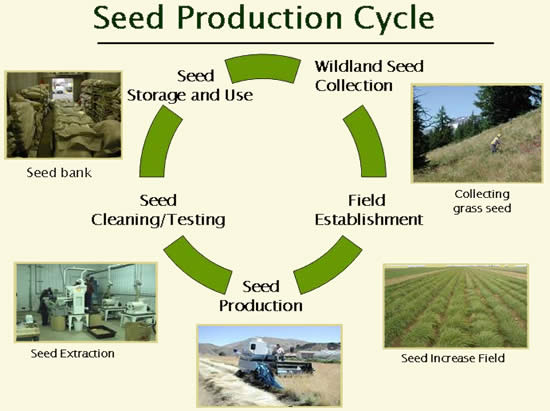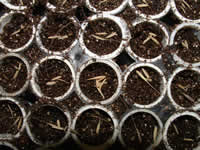USDA Forest Service Celebrating Wildflowers
|
|
|
 |
|
Developing Native Plant Materials for RestorationSeed and Nursery Stock ProductionSeed ProductionWildland collected native seed is quite valuable, and often only available in very limited amounts. For many native species, larger quantities of more affordable seed can be acquired by establishing wild collections in seed increase fields in nurseries or agronomic environments. Here, plants can be irrigated, fertilized, and cultured for heavy seed production for a period of several years. The field-grown seed can then be direct sown in restoration projects, or stored in a warehouse in anticipation of future needs.  Nursery Production
Planting stock with established root systems is often optimal for certain species, or for use in restoration projects that occur on very harsh or disturbed sites. In these situations, native seed is established and grown in nursery beds or in containers in a greenhouse for a period of time ranging from several months to several years. Plant size and stock type depends on several factors, including the number of growing seasons, the number of times the materials are transplanted, and/or the container size that the material is grown in. Most modern nurseries offer a variety of stock types, from bare root and container seedlings that can be grown in less than one year, to container transplants that take longer to produce, but can survive and grow on the most challenging restoration site.
At present, much of the native plant material used in restoration of public lands is grown at one of the six Forest Service Nurseries: Lucky Peak Nursery (Boise, ID), J. H. Stone Nursery (Medford, OR), Coeur d’Alene Nursery (Coeur d’Alene, ID), Placerville Nursery (Placerville, CA), Toumey Nursery (Waterstreet, MI), and Bessey Nursery (Halsey, NE). These nurseries have a long history of growing source-identified and locally adapted conifer seedlings for reforestation. Over the last 15 years, the traditional role of the Forest Service nurseries has expanded to include the production of a wide variety of additional native plant species to meet the increasing needs of ecosystem restoration. These opportunities present new challenges to nursery managers because little is known about propagating many of these new species.
 In addition to providing a reliable source of high quality native plant material, Forest Service nurseries are also a source of research and technology transfer in seedling production and quality. Information on how to produce native species and stock types is shared with other nurseries through technology transfer publications and workshops. These efforts enable other state and private nurseries, and nurseries worldwide, to develop successful methods for producing seed and seedlings for reforestation and restoration. Additional Resources and References
|
|
| NOTE: PDF format links require the Adobe Acrobat Reader to view. | |
| top | Disclaimers | FOIA | Privacy Policy | Quality of Information | Photo Credits & Use |
Location: http://www.fs.fed.us/wildflowers/nativeplantmaterials/stock.shtml
Last modified: Tuesday, 24-Jun-2008 21:54:57 EDT



